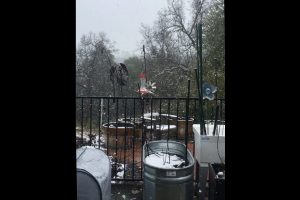As a patio container gardener with little space, I wondered about the use of cover crops. What are their functions and why would I use them? Cover crops have several different functions. They protect the soil surface, provide the soil with nutrition and aeration, let the soil rest and help control weed growth.
Cover crops are planted in the garden after harvesting edible crops, usually in the fall before winter’s first frost. They grow during late fall and winter until the soil warms enough to plant warm-season crops. The basic families of cover crops are:
- Grains and grasses such as rye, oats and wheat. These build biomass and break up soil compaction with their extensive roots. They improve water infiltration and protect the soil from rainstorms, stabilizing it against erosion.
- Legumes such as peas, clover, and vetch. They add nitrogen to the soil, reducing the need to add synthetic fertilizers.
- Broadleaf crops such as buckwheat, mustard and alyssum. These sprout quickly and shade out weeds. They are easy to turn under when spring arrives, adding nutrients into the soil.
Cover crops are sometimes called green manures because, when incorporated into the soil, they provide nutrients and biomass and their root systems break up soil compaction, increasing aeration. All help stabilize the soil and combat erosion. They help prevent weed growth and provide food for pollinators.
Rain and wind can erode bare soil surface, both in raised beds and in above-ground containers. Planting a cover crop can help avoid this. Raised beds or containers are often filled with fresh topsoil and/or compost when starting garden beds, but over time, rainfall can leach nutrients out of the soil. Cover crops help replace these nutrients.
I now garden on my patio in various containers, ranging from washtubs to half wine barrels to cattle water troughs along with other more conventional ones. This year I decided to try planting a cover crop. I chose crimson clover, spreading the seed on the soil in my containers after clearing out my summer crops. Woody stems from last summer’s vegetables remain in place to provide possible habitat for overwintering solitary bees and other insects. The clover has sprouted and I’m counting on winter rains to water it. Clover blossoms should be pretty to look at and will help early spring pollinators.
Gardening is always an adventure. My cover crop experiment brings these questions: will local deer find my clover too irresistible to leave enough for pollinators? How easy will it be to turn the clover into the container soil in the spring? No matter what happens, tending to my garden brings me purpose, peace and satisfaction.
Diane Miller is a University of California Cooperative Extension Master Gardener of Tuolumne County.
University of California Cooperative Extension Master Gardeners can answer gardening questions. In Tuolumne County call (209) 533-2912 and in Calaveras County call (209) 754-2880. You can fill out our easy-to-use problem questionnaire here. Check out our website here. You can also find us on Facebook.



